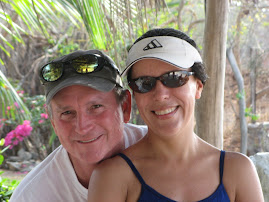
October 25-27, 2008
We’ve heard only good things about Oaxaca, which we have found true. The main thing we’ve not heard is how busy this town is. Bruce describes it, as other busy Mexican cities, like an anthill. Everyone is selling, working, making, servicing, repairing and has a task of some sort. The Mexicans work very hard 7 days a week and you don’t see or hear them complaining; it’s just a way of life. They appear to be content.


The city extends from the large and beautiful heavily treed zocolo (el centro) and has the nearby typical old churches, each with their own story and time of construction. All the buildings are spectacular in their own right. We stayed in the NE part of town the first night, but moved to the busier part of town (SW) the last few days. The former was a bit pricier and the latter reasonable and had better accommodations. The only downside is we have to walk through the sidewalk vendors to get to the zocolo. It’s like walking through a busy flea market every time we leave hotel.

We’ve adapted the habits of the Mexicans; light breakfast, large lunch around 1-2pm and a light dinner. The rest of the time we walk around the city admiring the sites and homemade products the vendors sell. Their textiles, chocolate and mole, hand painted pottery, painting, cooking and weaving is perfected from hundreds of years of practice. If you visit Oaxaca bring an empty suitcase and spending money, you’ll find great deals.
Sunday we went to the nearby archeological site called Monte Alban. It is believed this was started 500 BC by the Olmecs and later occupied by the Zapotecs. The location is on a hill that transects three valleys. We were amazed at how much manpower it must have taken to move the earth for the higher platforms and haul the stones for building the temples, residents, etc. Few parts are left as originally found which we appreciate as this was how it looked prior to “discovery”.



We’ve heard only good things about Oaxaca, which we have found true. The main thing we’ve not heard is how busy this town is. Bruce describes it, as other busy Mexican cities, like an anthill. Everyone is selling, working, making, servicing, repairing and has a task of some sort. The Mexicans work very hard 7 days a week and you don’t see or hear them complaining; it’s just a way of life. They appear to be content.
Photo right: There is always music in Mexico! Below: Yucca plants in front of Santa Domingo Iglesia.


The city extends from the large and beautiful heavily treed zocolo (el centro) and has the nearby typical old churches, each with their own story and time of construction. All the buildings are spectacular in their own right. We stayed in the NE part of town the first night, but moved to the busier part of town (SW) the last few days. The former was a bit pricier and the latter reasonable and had better accommodations. The only downside is we have to walk through the sidewalk vendors to get to the zocolo. It’s like walking through a busy flea market every time we leave hotel.
Photos left and below: Grasshoppers, I think fried, are a tasty snack...I do not have the intestinal fortitude to try them. Flowers, food wrapped in leaves and stuffed chicken at the market.

We’ve adapted the habits of the Mexicans; light breakfast, large lunch around 1-2pm and a light dinner. The rest of the time we walk around the city admiring the sites and homemade products the vendors sell. Their textiles, chocolate and mole, hand painted pottery, painting, cooking and weaving is perfected from hundreds of years of practice. If you visit Oaxaca bring an empty suitcase and spending money, you’ll find great deals.
Photo right: While in the zocolo Bruce made fast friends with these students (ages 13-14) who approached him and practiced their English. L>R Roy, Concepcion, Elizabeth and Pancho.
A golden lizard basks in the sun at Monte Alban.
Sunday we went to the nearby archeological site called Monte Alban. It is believed this was started 500 BC by the Olmecs and later occupied by the Zapotecs. The location is on a hill that transects three valleys. We were amazed at how much manpower it must have taken to move the earth for the higher platforms and haul the stones for building the temples, residents, etc. Few parts are left as originally found which we appreciate as this was how it looked prior to “discovery”.


To improve our Spanish we decided to stay the week in Oaxaca and take a Spanish class. We found a school (Oaxaca International) that will accommodate Bruce’s schedule (2 hours/day) and my schedule (4 hours/day – only because they don’t have an 8 hour/day course). The remaining time will be spent eating, drinking the varieties of fruit juice, walking and studying Espanol.

Oaxaca's zocolo in the morning.





No comments:
Post a Comment